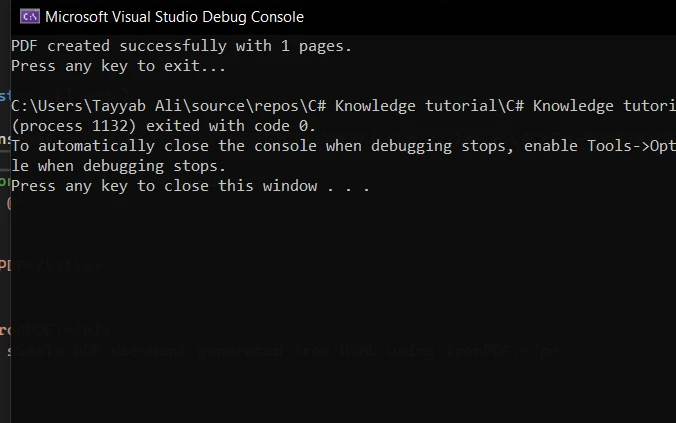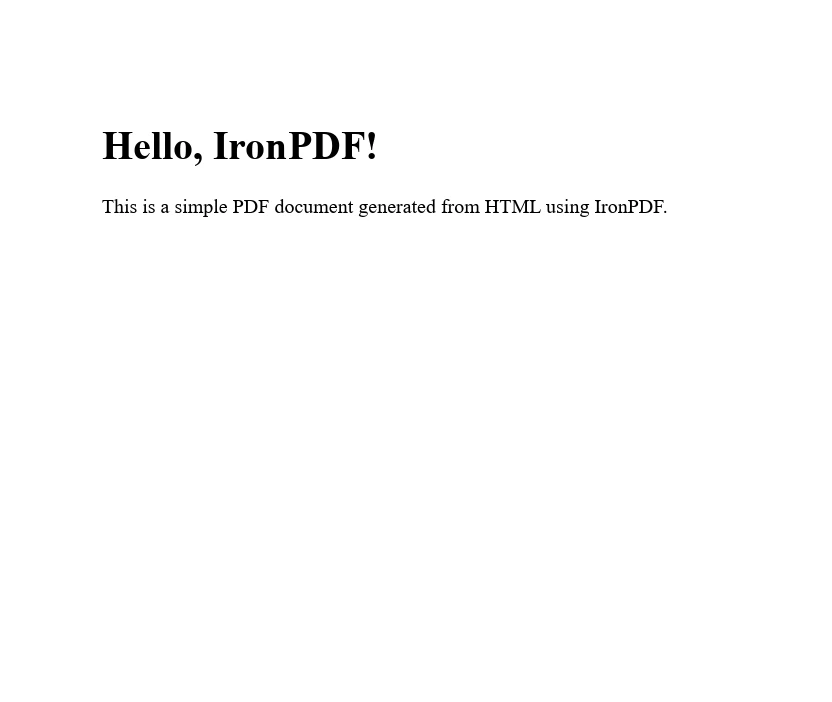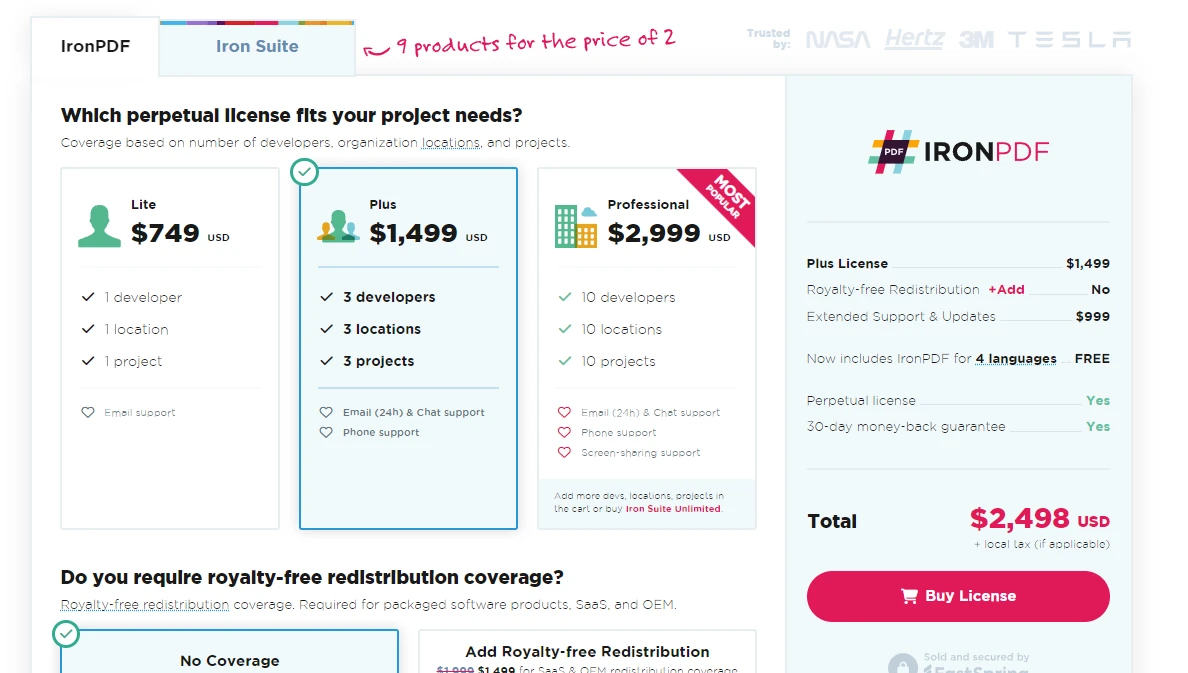透かしなしで本番環境でテストしてください。
必要な場所で動作します。
30日間、完全に機能する製品をご利用いただけます。
数分で稼働させることができます。
製品トライアル期間中にサポートエンジニアリングチームへの完全アクセス
C#のNull条件演算子は、コード内でnull値を扱うためのより簡潔で安全な方法を提供します。 このオペレータの美点は、null チェックを簡素化し、コードをよりクリーンで読みやすくする能力にあります。
詳細について見てみましょう。null`条件演算子作用、利点、そしてプロジェクトでの使用方法。 また、以下を探りますIronPDFとその使用例と Null 条件演算子の使用例を説明すること。
null条件演算子は、その形がエルヴィス・プレスリーの髪型に似ていることから「エルヴィス演算子」とも呼ばれます。(おそらく、提供されたコンテンツが不足しているか、形式が正しくありません。翻訳するために、完全な英語テキストを提供してください。)、オブジェクトがnullでない場合にのみ、そのオブジェクトのメンバーアクセスまたはメソッド呼び出しを実行できるようにします。
オブジェクトがnullの場合、操作はnull参照例外をスローする代わりにnullを返します。 このオペレーターは、開発者にとって画期的なものであり、nullである可能性のあるオブジェクトのメンバーに安全にアクセスするために必要なコードの量を大幅に削減します。
ヌル条件演算子を理解するために、public class Employee の例を考えてみましょう。 このクラスは、public string FirstName や public string LastName のようなプロパティを持つかもしれません。 従来のC#コードでは、例外を回避するために、潜在的にnullであるEmployeeオブジェクトのプロパティにアクセスする際に明示的なnullチェックが必要です。
if (employee != null)
{
var name = employee.FirstName;
}if (employee != null)
{
var name = employee.FirstName;
}If employee IsNot Nothing Then
Dim name = employee.FirstName
End Ifしかし、null条件演算子(null conditional operator)を使用すると、これを1行に簡略化することができます。
var name = employee?.FirstName;var name = employee?.FirstName;Dim name = employee?.FirstNameemployeeがnullでない場合、name変数はemployee.FirstNameの値を受け取ります。 employee が null の場合、name は null に設定されます。 この1行のコードは、そのため、複数行の明示的なnullチェックを優雅に置き換えます。
ヌル条件演算子は、Xamarinフレームワークと組み合わせることで、さらに強力になります。null 合体代入演算子 (??=). null合体演算子を使用すると、式がnullに評価された場合にデフォルト値を指定することができます。
例えば、name変数がnullではなく"Unknown"というデフォルト値を持つようにしたい場合、次のように記述できます:
var name = employee?.FirstName ?? "Unknown";var name = employee?.FirstName ?? "Unknown";Dim name = If(employee?.FirstName, "Unknown")このコードは、employee が null であるかどうかを確認し、employee.FirstName が null の場合に name に "Unknown" を代入します。 null値を一つの操作で優雅に処理し、コードがいかに簡潔で効果的になるかを示しています。
C#では、null許容型が導入されました。これは、変数がその基礎となる型のnull以外の値またはnullを保持できるようにするものです。
コレクションを扱う際に、null 参照の例外を回避するために、null 条件演算子を使用して要素にアクセスすることができます。 従業員のリストがあり、最初の要素の名前を安全にアクセスしたいとします。 次のように角括弧を使用してオペレーターを使用できます:
var firstName = employees?[0]?.FirstName ?? "Unknown";var firstName = employees?[0]?.FirstName ?? "Unknown";Dim firstName = If(employees?(0)?.FirstName, "Unknown")このコード行はスレッドセーフです。これは、別のスレッドが employees をnullチェック後にnullに変更しても、その最初の要素にアクセスする前の段階であなたのコードがクラッシュしないことを意味します。 ヌル許容型を扱う際には、その基盤となる値型、つまりヌル許容型に関連する非ヌル許容型を理解することが重要です。
null条件演算子を使用する際の微妙な点の一つは、そのスレッドセーフ機能です。 このオペレーターを使用すると、式の評価はスレッドセーフになります。 これは、他のスレッドによって変更される可能性のある共有リソースにアクセスする場合に、null 条件演算子を使用することで潜在的な競合状態を防止できることを意味します。
ただし、演算子自体は実行する操作に対してスレッドセーフであっても、コードブロック全体や一連の操作に対してスレッドセーフであることを保証するものではないことを理解することが重要です。
オブジェクトがイベントを発生させる可能性がある、より実践的な例を考えてみましょう。 従来のC#では、null参照例外を避けるために、イベントを呼び出す前にイベントハンドラーがnullであるかどうかを確認します。
if (PropertyChanged != null)
{
PropertyChanged(this, new PropertyChangedEventArgs(name));
}if (PropertyChanged != null)
{
PropertyChanged(this, new PropertyChangedEventArgs(name));
}If PropertyChanged IsNot Nothing Then
PropertyChanged(Me, New PropertyChangedEventArgs(name))
End Ifnull条件演算子を使用すると、これは次のように簡略化できます:
PropertyChanged?.Invoke(this, new PropertyChangedEventArgs(name));PropertyChanged?.Invoke(this, new PropertyChangedEventArgs(name));If PropertyChanged IsNot Nothing Then
PropertyChanged.Invoke(Me, New PropertyChangedEventArgs(name))
End Ifこの簡潔なコードは、より読みやすく安全な方法で同じ結果を達成します。 明示的にnullを返したいシナリオでは、単にreturn null;文を使用することができます。 ?. 演算子は、PropertyChanged が null の場合に処理を短絡し、例外の発生を防ぎます。 以下が全てのコードです:
using System.ComponentModel;
public class Person : INotifyPropertyChanged
{
private string name;
public event PropertyChangedEventHandler PropertyChanged;
public string Name
{
get { return name; }
set
{
if (name != value)
{
name = value;
OnPropertyChanged(nameof(Name));
}
}
}
protected virtual void OnPropertyChanged(string propertyName)
{
// Using the null conditional operator to safely invoke the event
PropertyChanged?.Invoke(this, new PropertyChangedEventArgs(propertyName));
}
}
class Program
{
static void Main(string [] args)
{
Person person = new Person();
person.PropertyChanged += (sender, e) =>
{
Console.WriteLine($"{e.PropertyName} property has changed.");
};
person.Name = "Iron Software"; // This will trigger the PropertyChanged event
}
}using System.ComponentModel;
public class Person : INotifyPropertyChanged
{
private string name;
public event PropertyChangedEventHandler PropertyChanged;
public string Name
{
get { return name; }
set
{
if (name != value)
{
name = value;
OnPropertyChanged(nameof(Name));
}
}
}
protected virtual void OnPropertyChanged(string propertyName)
{
// Using the null conditional operator to safely invoke the event
PropertyChanged?.Invoke(this, new PropertyChangedEventArgs(propertyName));
}
}
class Program
{
static void Main(string [] args)
{
Person person = new Person();
person.PropertyChanged += (sender, e) =>
{
Console.WriteLine($"{e.PropertyName} property has changed.");
};
person.Name = "Iron Software"; // This will trigger the PropertyChanged event
}
}Imports System.ComponentModel
Public Class Person
Implements INotifyPropertyChanged
'INSTANT VB NOTE: The field name was renamed since Visual Basic does not allow fields to have the same name as other class members:
Private name_Conflict As String
Public Event PropertyChanged As PropertyChangedEventHandler Implements INotifyPropertyChanged.PropertyChanged
Public Property Name() As String
Get
Return name_Conflict
End Get
Set(ByVal value As String)
If name_Conflict <> value Then
name_Conflict = value
OnPropertyChanged(NameOf(Name))
End If
End Set
End Property
Protected Overridable Sub OnPropertyChanged(ByVal propertyName As String)
' Using the null conditional operator to safely invoke the event
RaiseEvent PropertyChanged(Me, New PropertyChangedEventArgs(propertyName))
End Sub
End Class
Friend Class Program
Shared Sub Main(ByVal args() As String)
Dim person As New Person()
AddHandler person.PropertyChanged, Sub(sender, e)
Console.WriteLine($"{e.PropertyName} property has changed.")
End Sub
person.Name = "Iron Software" ' This will trigger the PropertyChanged event
End Sub
End Class以下はコードの出力です:

IronPDFC#開発者向けの多用途ライブラリであり、作成、編集、PDFコンテンツの抽出.NETアプリケーション内で。 このライブラリは使いやすさと、PDF機能をどんな.NETプロジェクトにもシームレスに統合できる能力で際立っています。
HTML to PDF. This capability is essential for developers who need to generate reports, invoices, or any document from web content quickly and accurately. With IronPDF, you can easily convert entire webpages or parts of them into PDFs while maintaining the layout, graphics, and text formatting just as they appear on the screen.スタイルを完全に保持したHTMLからPDFへの翻訳、完全なレイアウトとスタイルを保持しています。 WebコンテンツからPDFを生成するための素晴らしいソリューションであり、レポート、請求書、およびドキュメントが含まれます。 HTMLファイル、URL、およびHTML文字列からPDFファイルへの変換をサポートします。
using IronPdf;
class Program
{
static void Main(string[] args)
{
var renderer = new ChromePdfRenderer();
// 1. Convert HTML String to PDF
var htmlContent = "<h1>Hello, IronPDF!</h1><p>This is a PDF from an HTML string.</p>";
var pdfFromHtmlString = renderer.RenderHtmlAsPdf(htmlContent);
pdfFromHtmlString.SaveAs("HTMLStringToPDF.pdf");
// 2. Convert HTML File to PDF
var htmlFilePath = "path_to_your_html_file.html"; // Specify the path to your HTML file
var pdfFromHtmlFile = renderer.RenderHtmlFileAsPdf(htmlFilePath);
pdfFromHtmlFile.SaveAs("HTMLFileToPDF.pdf");
// 3. Convert URL to PDF
var url = "http://ironpdf.com"; // Specify the URL
var pdfFromUrl = renderer.RenderUrlAsPdf(url);
pdfFromUrl.SaveAs("URLToPDF.pdf");
}
}using IronPdf;
class Program
{
static void Main(string[] args)
{
var renderer = new ChromePdfRenderer();
// 1. Convert HTML String to PDF
var htmlContent = "<h1>Hello, IronPDF!</h1><p>This is a PDF from an HTML string.</p>";
var pdfFromHtmlString = renderer.RenderHtmlAsPdf(htmlContent);
pdfFromHtmlString.SaveAs("HTMLStringToPDF.pdf");
// 2. Convert HTML File to PDF
var htmlFilePath = "path_to_your_html_file.html"; // Specify the path to your HTML file
var pdfFromHtmlFile = renderer.RenderHtmlFileAsPdf(htmlFilePath);
pdfFromHtmlFile.SaveAs("HTMLFileToPDF.pdf");
// 3. Convert URL to PDF
var url = "http://ironpdf.com"; // Specify the URL
var pdfFromUrl = renderer.RenderUrlAsPdf(url);
pdfFromUrl.SaveAs("URLToPDF.pdf");
}
}Imports IronPdf
Friend Class Program
Shared Sub Main(ByVal args() As String)
Dim renderer = New ChromePdfRenderer()
' 1. Convert HTML String to PDF
Dim htmlContent = "<h1>Hello, IronPDF!</h1><p>This is a PDF from an HTML string.</p>"
Dim pdfFromHtmlString = renderer.RenderHtmlAsPdf(htmlContent)
pdfFromHtmlString.SaveAs("HTMLStringToPDF.pdf")
' 2. Convert HTML File to PDF
Dim htmlFilePath = "path_to_your_html_file.html" ' Specify the path to your HTML file
Dim pdfFromHtmlFile = renderer.RenderHtmlFileAsPdf(htmlFilePath)
pdfFromHtmlFile.SaveAs("HTMLFileToPDF.pdf")
' 3. Convert URL to PDF
Dim url = "http://ironpdf.com" ' Specify the URL
Dim pdfFromUrl = renderer.RenderUrlAsPdf(url)
pdfFromUrl.SaveAs("URLToPDF.pdf")
End Sub
End Classレポート、請求書、またはPDF形式のドキュメントを生成する際、IronPDFはこれらのタスクを効率的に達成するための包括的なツールセットを提供します。
null 条件演算子と共にIronPDFをプロジェクトに統合することで、アプリケーションの堅牢性を大幅に向上させることができます。 この組み合わせは、nullの可能性があるPDFコンテンツを扱う場合や、null値になる可能性のある操作を行う場合に特に有用です。
HTMLコンテンツからPDFドキュメントを生成するためにIronPDFを使用する簡単な例を見てみましょう。 次に、null条件演算子を使用してドキュメントのプロパティに安全にアクセスし、null値を優雅に処理する方法を示します。
まず、プロジェクトにIronPDFを追加する必要があります。 NuGetパッケージマネージャーを通じてこれを行うことができます:
Install-Package IronPdf
以下のコードを program.cs ファイルに書き込んでください。
using IronPdf;
using System;
public class PdfGenerator
{
public static void CreatePdf(string htmlContent, string outputPath)
{
// Instantiate the HtmlToPdf converter
var renderer = new IronPdf.ChromePdfRenderer();
// Generate a PDF document from HTML content
var pdfDocument = renderer.RenderHtmlAsPdf(htmlContent);
// Use the null conditional operator to safely access the document's properties
var pageCount = pdfDocument?.PageCount ?? 0;
// Check if the PDF was generated successfully and has pages
if (pageCount > 0)
{
// Save the PDF document to the specified output path
pdfDocument.SaveAs(outputPath);
Console.WriteLine($"PDF created successfully with {pageCount} pages.");
}
else
{
// Handle cases where the PDF generation fails or returns null
Console.WriteLine("Failed to create PDF or the document is empty.");
}
}
public static void Main(string [] args)
{
// Define the HTML content for the PDF document
string htmlContent = @"
<html>
<head>
<title>Test PDF</title>
</head>
<body>
<h1>Hello, IronPDF!</h1>
<p>This is a simple PDF document generated from HTML using IronPDF.</p>
</body>
</html>";
// Specify the path where the PDF document will be saved
// Ensure this directory exists on your machine or adjust the path accordingly
string filePath = @"F:\GeneratedPDF.pdf";
// Call the method to generate and save the PDF document
CreatePdf(htmlContent, filePath);
// Wait for user input before closing the console window
Console.WriteLine("Press any key to exit...");
Console.ReadKey();
}
}using IronPdf;
using System;
public class PdfGenerator
{
public static void CreatePdf(string htmlContent, string outputPath)
{
// Instantiate the HtmlToPdf converter
var renderer = new IronPdf.ChromePdfRenderer();
// Generate a PDF document from HTML content
var pdfDocument = renderer.RenderHtmlAsPdf(htmlContent);
// Use the null conditional operator to safely access the document's properties
var pageCount = pdfDocument?.PageCount ?? 0;
// Check if the PDF was generated successfully and has pages
if (pageCount > 0)
{
// Save the PDF document to the specified output path
pdfDocument.SaveAs(outputPath);
Console.WriteLine($"PDF created successfully with {pageCount} pages.");
}
else
{
// Handle cases where the PDF generation fails or returns null
Console.WriteLine("Failed to create PDF or the document is empty.");
}
}
public static void Main(string [] args)
{
// Define the HTML content for the PDF document
string htmlContent = @"
<html>
<head>
<title>Test PDF</title>
</head>
<body>
<h1>Hello, IronPDF!</h1>
<p>This is a simple PDF document generated from HTML using IronPDF.</p>
</body>
</html>";
// Specify the path where the PDF document will be saved
// Ensure this directory exists on your machine or adjust the path accordingly
string filePath = @"F:\GeneratedPDF.pdf";
// Call the method to generate and save the PDF document
CreatePdf(htmlContent, filePath);
// Wait for user input before closing the console window
Console.WriteLine("Press any key to exit...");
Console.ReadKey();
}
}Imports IronPdf
Imports System
Public Class PdfGenerator
Public Shared Sub CreatePdf(ByVal htmlContent As String, ByVal outputPath As String)
' Instantiate the HtmlToPdf converter
Dim renderer = New IronPdf.ChromePdfRenderer()
' Generate a PDF document from HTML content
Dim pdfDocument = renderer.RenderHtmlAsPdf(htmlContent)
' Use the null conditional operator to safely access the document's properties
Dim pageCount = If(pdfDocument?.PageCount, 0)
' Check if the PDF was generated successfully and has pages
If pageCount > 0 Then
' Save the PDF document to the specified output path
pdfDocument.SaveAs(outputPath)
Console.WriteLine($"PDF created successfully with {pageCount} pages.")
Else
' Handle cases where the PDF generation fails or returns null
Console.WriteLine("Failed to create PDF or the document is empty.")
End If
End Sub
Public Shared Sub Main(ByVal args() As String)
' Define the HTML content for the PDF document
Dim htmlContent As String = "
<html>
<head>
<title>Test PDF</title>
</head>
<body>
<h1>Hello, IronPDF!</h1>
<p>This is a simple PDF document generated from HTML using IronPDF.</p>
</body>
</html>"
' Specify the path where the PDF document will be saved
' Ensure this directory exists on your machine or adjust the path accordingly
Dim filePath As String = "F:\GeneratedPDF.pdf"
' Call the method to generate and save the PDF document
CreatePdf(htmlContent, filePath)
' Wait for user input before closing the console window
Console.WriteLine("Press any key to exit...")
Console.ReadKey()
End Sub
End Classプログラムを実行したときのコンソール出力は次のとおりです:

そして、これはプログラムによって生成されたPDFです:


C#プロジェクトでIronPDFをnull条件演算子と統合することで、PDF処理タスクを大幅に簡素化し、null参照例外からコードを安全に保つことができます。 この例は、強力なPDFライブラリと最新のC#言語機能の相乗効果を示し、よりクリーンで保守しやすいコードを書けるようにするものです。
これらのツールを効果的に使用するための鍵は、その機能を理解し、あなたのプロジェクトに適切に適用することにあります。
IronPDFは開発者に対して無料のフルサポートとアップデートを提供するトライアルLiteライセンスが必要です。